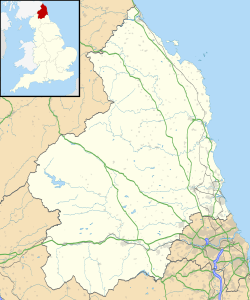Hunnum facts for kids
Quick facts for kids Onnum (Halton Chesters) |
|
|---|---|
| Northumberland, England, UK | |

The gateway to Halton Castle is located near the middle of the former fort
|
|
|
Location in Northumberland
|
|
| Coordinates | 55°00′36″N 2°00′22″W / 55.010°N 2.006°W |
Hunnum, also known as Onnum or Halton Chesters, was a Roman fort. It was built north of the village of Halton in Northumberland, North East England. The Roman name "Onnum" might have meant "Stream," "Water," "Ash tree," or "Rock." If it meant "Stream," it could refer to the Fence Burn, a stream near Hadrian's Wall. If it meant "Rock," it might be about Down Hill, which is to the east.
Hunnum was the fifth fort built along Hadrian's Wall. It came after Segedunum (Wallsend), Pons Aelius (Newcastle), Condercum, and Vindobala. The fort was about seven and a half miles west of Vindobala. It was also two and a half miles north of Corstopitum. Today, the B6318 Military Road cuts through the middle of the old fort site. This road follows the path of Hadrian's Wall in that area.
Contents
What Was Hunnum?
The Hunnum fort was important because it guarded Dere Street. This was a major Roman road that crossed Hadrian's Wall through a valley just west of the fort.
Fort Layout and Design
The original fort was shaped like a rectangle. It measured about 460 feet (140 meters) from north to south. It was also about 410 feet (125 meters) from east to west. Later, the part of the fort south of Hadrian's Wall was made longer towards the west. This made the southern wall of the fort about 570 feet (174 meters) long. Because of this change, the fort looked like an "L" shape. The northern part covered about 4.3 acres, and the southern part covered about 4.8 acres.
The fort had four main gates, one for each main direction (north, south, east, west). Each gate had two openings and special rooms for guards. Over time, some of these openings were blocked up. Both openings of the west gate were blocked almost right away. There were also towers at each corner of the fort. More towers stood on either side of the main gates. Experts believe the fort was built between 122 AD and 126 AD.
The Vallum was a large ditch and earthwork built south of Hadrian's Wall. It passed a short distance south of the Hunnum fort. A road led from the fort's south gate across the Vallum. This road went to a small Roman town, called a vicus, which was just south of the Vallum.
Who Lived at the Fort?
A special stone slab found at the fort's west gate tells us who built it. The Legio VI Victrix, a Roman legion (a large army unit), was responsible for the first building work. At first, the fort was probably home to about 500 soldiers. These soldiers were partly mounted, meaning some rode horses.
Later, in the third century, a cavalry unit lived there. This unit was called the Ala I Pannoniorum Sabiniana, or Ala Sabiniana. It was named after Sabinus, the person who first created this cavalry group.
Discovering the Past
The northern part of the fort is in a field north of the Military Road. In 1827, this field was plowed for the first time. During this work, a very nice bath-house was found. This bath-house had several rooms for bathing. It included dry hot rooms, moist hot rooms, a warm room, and cold rooms. There was also a dressing room. Finding such a large bath-house on Hadrian's Wall is quite rare.
See also
 In Spanish: Hunnum para niños
In Spanish: Hunnum para niños


